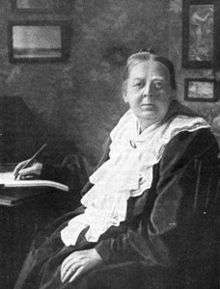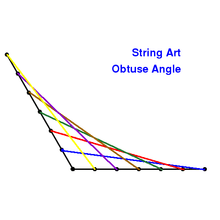Mary Everest Boole


Mary Everest Boole (1832, Wickwar, Gloucestershire – 1916) was a self-taught mathematician who is best known as an author of didactic works on mathematics, such as Philosophy and Fun of Algebra, and as the wife of fellow mathematician George Boole. Her progressive ideas on education, as expounded in The Preparation of the Child for Science, included encouraging children to explore mathematics through playful activities such as curve stitching. Her life is of interest to feminists as an example of how women made careers in an academic system that did not welcome them.
Life
She was born Mary Everest in England, the daughter of Reverend Thomas Roupell Everest, Rector of Wickwar, and Mary nee Ryall. Her uncle was George Everest, the surveyor and geographer after whom Mount Everest was named. She spent the first part of her life in France where she received an education in mathematics from a private tutor. On returning to England at the age of 11, she continued to pursue her interest in mathematics through self-instruction. George Boole became her tutor in 1852, and on the death of her father in 1855, they married and moved to Cork County, Ireland. Mary greatly contributed as an editor to Boole's The Laws of Thought, a work on algebraic logic. She had five daughters by him.
She was widowed in 1864, at the age of 32, and returned to England where she was offered a post as a librarian at Queen's College, London. She also tutored privately in mathematics and developed a philosophy of teaching that involved the use of natural materials and physical activities to encourage an imaginative conception of the subject. Her interest extended beyond mathematics to Darwinian theory, philosophy and psychology and she organised discussion groups on these subjects among others. In later life, she belonged to the circle of the Tolstoyan pacifist publisher, C. W. Daniel; she chose the name The Crank for his magazine because, she said, 'a crank was a little thing that made revolutions'.[1]
She died in 1916, at the age of 84.
Contributions to education
Mary first became interested in mathematics and teaching through her tutor in France, Monsieur Deplace. He helped her understand mathematics through questioning and journal writing. After marrying George Boole she began contributing to the scientific world by advising her husband in his work while attending his lectures, both of which were unheard of for a woman to do in that time period.[2] During this time she also shared ideas with Victoria Welby, another female scholar and dear friend. They discussed everything from logic and mathematics, to pedagogy, theology, and science.[3]
Her teaching first began while working as a librarian. Mary would tutor students with new methods; using natural objects, such as sticks or stones. She theorized that using physical manipulations would strengthen the unconscious understanding of materials learned in a classroom setting.[4] One of her most notable contributions in the area of physical manipulations is curve stitching with the use of sewing cards, which she discovered as a form of amusement as a child.[5] This helped to encourage the connections of mathematical concepts to outside sources.
Her book Philosophy and Fun of Algebra explained algebra and logic to children in interesting ways, starting with a fable, and including bits of history throughout.[6] She references not only history, but also philosophy and literature, using a mystical tone to keep the attention of children.[7] Mary encouraged the use of mathematical imagination with critical thinking and creativity. This, along with reflective journal writing and creating one's own formulas, was essential in strengthening comprehension and understanding. Cooperative learning was also important because students could share discoveries with each other in an environment of peer tutoring and develop new ideas and methods.[8]
She worked on promoting her husband's works, with great attention to mathematical psychology. George Boole's main focus was on psychologism, and Mary provided a more ideological view of his work. She supported the idea that arithmetic was not purely abstract as many believed, but more anthropomorphic. Pulsation was also important in her works and could be described as a sequence of mental attitudes, with her attention being analysis and synthesis.[9]
Spiritualism
Boole was interested in parapsychology and the occult, and was a convinced spiritualist. She was the first female member of the Society for Psychical Research which she joined in 1882. However, being the only female member at the time, she resigned after six months.[10]
Boole was the author of the book The Message of Psychic Science for Mothers and Nurses. She revealed the manuscript to Frederick Denison Maurice who objected to its controversial ideas and this resulted in her losing her job as librarian at Queens College.[11] The book was not published until 1883.[12] It was later republished as The Message of Psychic Science to the World (1908).
Boole was a practitioner of homeopathic medicine.[13]
Family
Her five daughters made their marks in a range of fields. Alicia Boole Stott (1860–1940) became an expert in four-dimensional geometry. Ethel Lilian (1864–1960) married the Polish revolutionary Wilfrid Michael Voynich and was the author of a number of works including The Gadfly. Mary Ellen married mathematician Charles Hinton and Margaret (1858–1935) was the mother of mathematician G. I. Taylor. Lucy Everest (1862–1905) was a talented chemist and became the first woman Fellow of the Institute of Chemistry.[14]
Mary Everest Boole's husband fell ill in 1864, after he had walked two miles in the drenching rain and then lectured wearing his wet clothes. He developed a severe cold and high fever. Mary put her husband to bed and - since she believed in the principle of analogies and like cures like - thought pouring buckets of water over him might help. Tragically, this made him worse; on 8 December 1864, he died of fever-induced pleural effusion.
Publications
- Boole, M. (1883). The Message of Psychic Science for Mothers and Nurses. London: Trübner & Co.
- Boole, M. (1884). Symbolical Methods of Study K. Paul, Trench & co.
- Boole, M. (1904). The Preparation of the Child for Science. Oxford: The Clarendon Press.
- Boole, M. (1908). The Message of Psychic Science to the World. London: C. W. Daniel.
- Boole, M. (1909). Philosophy and Fun of Algebra. London: C. W. Daniel.
- Boole, M. (1911). The Forging of Passion Into Power. M. Kennerley.
- Boole, M. (1972). A Boolean Anthology: Selected Writings of Mary Boole—On Mathematical Education (Compiled by D.G. Tahta). Association of Teachers of Mathematics.
References
- ↑ Anonymous A Tribute to Charles William Daniel (London: C.W.Daniel, 1955)
- ↑ Michalowicz, Karen Dee Ann. Vita Mathematica: Historical Research and Integration with Teaching. pp. 291–298.
- ↑ Petrilli, Susan (2010). "Three women in semiotics: Welby, Boole, Langer". Semiotica: Journal of the International Association for Semiotic Studies (182): 327. Retrieved 17 September 2013.
- ↑ Michalowicz, Karen Dee Ann. Vita Mathematica: Historical Research and Integration with Teaching. pp. 291–298.
- ↑ VALENTE, K. G. (2010). "Giving Wings to Logic: Mary Everest Boole's Propagation and Fulfilment of a Legacy". British Journal for the History of Science. 43 (1): 49–74. doi:10.1017/s0007087409990380. Retrieved 17 September 2013.
- ↑ Boole, M. E. (1909). Philosophy and Fun of Algebra. London.
- ↑ Peterson, Ivars. "Algebra, Philosophy, and Fun". Science News. Society for Science & The Public. Retrieved 17 September 2013.
- ↑ Michalowicz, Karen Dee Ann. Vita Mathematica: Historical Research and Integration with Teaching. pp. 291–298.
- ↑ VALENTE, K. G. (2010). "Giving Wings to Logic: Mary Everest Boole's Propagation and Fulfilment of a Legacy". British Journal for the History of Science. 43 (1): 49–74. doi:10.1017/s0007087409990380. Retrieved 17 September 2013.
- ↑ Haynes, Renee. (1982). The Society for Psychical Research 1882-1982: A History. London: MacDonald & Co. p. 5. ISBN 978-0356078755
- ↑ Pinch, Adela. (2010). Thinking about Other People in Nineteenth-Century British Writing. Cambridge University Press. p. 58. ISBN 978-0521764643
- ↑ Oakes, Elizabeth H. (2007). Encyclopedia of World Scientists. Facts on File. p. 80
- ↑ Nahin, Paul J. (2012). The Logician and the Engineer: How George Boole and Claude Shannon Created the Information Age. Princeton University Press. p. 28. ISBN 978-0691151007
- ↑ Marelene F. Rayner-Canham, Geoffrey Rayner-Canham, p.159, Chemistry was their life: pioneering British women chemists, 1880–1949
- Batchelor, George (1994). The Life and Legacy of G. I. Taylor. Cambridge University Press. p. 7. ISBN 0-521-46121-9.
- Michalowicz, Karen Dee Ann (1996). "Mary Everest Boole: An Erstwhile Pedagogist for Contemporary Times". In Ronald Calinger. Vita Mathematica: Historical Research and Integration with Teaching. Washington, DC: Mathematical Association of America. pp. 291–299. ISBN 0-88385-097-4.
- Petrilli, Susan (2010). "Three women in semiotics: Welby, Boole, Langer". Semiotica: Journal of the International Association for Semiotic Studies (182): 327. Retrieved 17 September 2013.
- VALENTE, K. G. (2010). "Giving Wings to Logic: Mary Everest Boole's Propagation and Fulfilment of a Legacy". British Journal for the History of Science. 43 (1): 49–74. doi:10.1017/s0007087409990380. Retrieved 17 September 2013.
- Boole, M. E. (1909). Philosophy and Fun of Algebra. London.
- Peterson, Ivars. "Algebra, Philosophy, and Fun". Science News. Society for Science & The Public. Retrieved 17 September 2013.
External links
| Wikisource has original works written by or about: Mary Everest Boole |
- "Mary Everest Boole", Biographies of Women Mathematicians, Agnes Scott College
- Biography and picture
- Works by Mary Everest Boole at Project Gutenberg
- Works by or about Mary Everest Boole at Internet Archive
- Works by Mary Everest Boole at LibriVox (public domain audiobooks)
